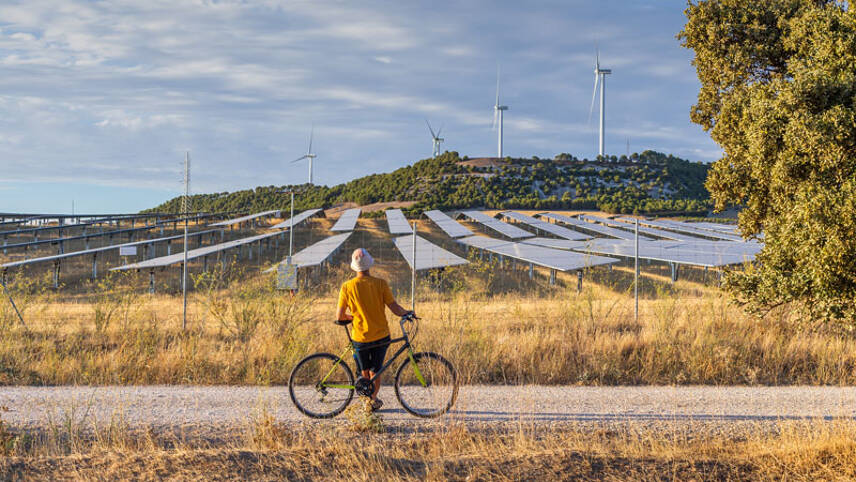Register for free and continue reading
Join our growing army of changemakers and get unlimited access to our premium content

Pictured: A cyclist with wind turbines and solar panels in Castilla y Leon, Spain
As such, the bloc needs to accelerate and expand programmes that are working well, while making further interventions. If not, it risks missing its binding climate goals including net-zero carbon by 2050.
That is according to a new report from McKinsey this week. The report sets out five key ‘action areas’ for EU policymakers, that, if implemented, would ensure a more rapid and more orderly transition to a low-carbon energy system.
The report does acknowledge that the EU has “long been a leader in the global transition” and has continued to show leadership by responding rapidly to the energy price crisis. It built upon its Green Deal and Fit for 55 Plan following Russia’s invasion of Ukraine with new emergency measures on energy efficiency and transitioning away from Russian fossil fuel imports.
Nonetheless, the bloc is not on track for a net-zero energy system by 2050, the report states.
It also outlines that it is not properly planning to harness the socio-economic benefits of the transition and shield vulnerable businesses and workers from related risks. While the transition will likely result in a net gain of five million jobs through 2050, efforts will be needed around reskilling and upskilling to minimise disruption.
This will need to be underpinned by clarity on the appropriate technology mixes, so that businesses can invest in not only skills but in infrastructure at the right time and in the right place. A less orderly transition could increase energy generation, transport and storage costs, the report warns.
Key action areas
In addition to planning properly for skills needs with industry, the report calls on EU policymakers to focus on five ‘key action areas’ for a more rapid and orderly clean energy transition. They are as follows:
- Creating resilient supply chains for key low-carbon technologies
- Building out energy grid infrastructure
- Re-examining land use to strategically plan for faster renewable development
- Redesigning power market rules in line with cost and carbon objectives
- Making clean technologies more affordable
Without additional focus, the EU risks missing its RePowerEU aims to rapidly build out solar and other clean energy sources. It is aiming to almost treble solar capacity this decade, for example, from 209GW in 2022 to 600GW by 2030.
On the build-out of energy grid infrastructure, the report states that annual grid investments of up to 70% more than the average over the past five years are needed. This will enable the grid to cope with increasing renewable generation and higher demand for electricity, as sectors like heat and transportation continue to electrify.
Investment in flexibility will also be key to minimising the cost of grid built-out; the report states that the need for flexibility is likely to triple by 2030. It explains that Europe’s population density makes it a more challenging geography to build out new infrastructure, making demand-side interventions a sensible choice.
Other recommendations in the report include streamlining permitting procedures for renewables and grid infrastructure; rethinking bans on renewables in and near certain buildings such as airports; running public engagement campaigns on renewables and energy efficiency, and developing financial incentives for emerging technologies like next-generation energy storage.
Regarding finance for key technologies, the EU unveiled a new ‘Net-Zero Industry Act’ in March. The Act sets out an aim for 40% of nuclear and renewable energy technologies used within the EU to be manufactured there by the end of the decade. It also outlines plans for financing the expansion of manufacturing, including subsidies and R&D grants. It is widely described as a rival to the US’s Inflation Reduction Act, which set aside $369bn for low-carbon tech, green skills training and climate adaptation.
The Mckinsey report concludes: “For the European Union, a successful energy transition amid geopolitical and macroeconomic turbulence would probably require sustained will, cooperation, and coordination among all stakeholders—including operators, regulators, investors, and society at large.”
Related blog: CISL on why the EU needs to think ‘bigger and bolder’ around the Net-Zero Industry Act


Please login or Register to leave a comment.